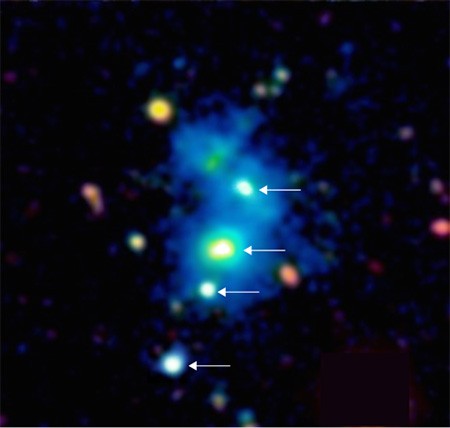'Extremely Impossible' Quasar Quartet Reveals Universe from 10 Billion Years Ago
| Ana Verayo | | May 16, 2015 06:27 AM EDT |
(Photo : Hennawi & Arrigoni-Battaia, MPIA/UCSC) This quasar quartet are found inside a giant nebula that spans one million light years across.
Astronomers have now discovered the first ever quadruple quasar that is apparenlty one of the most massive structures found from the farthest reaches of the universe.
This unique quasar formation is enshrouded within a giant nebula made from cool, dense gases. Scientists consider this discovery a one in a ten million chance that suggests the development of newer models of quasar systems and how they evolve into the universe's most colossal structures ever to be detected.
Like Us on Facebook
These four quasars are surrounded by a giant nebula that consists of cool hydrogen gas that also emits light since it is irradiated by the intense energy of the glow of quasars. The nebula also measures one million light years across.
Another surprising discovery for astronomers is that the surrounding nebula and the quartet of quasars are all located in a rare region in the universe that contains a huge amount of matter.
According to J. Xavier Prochaska from the University of California, Santa Cruz, the amount of galaxies in this region is 700 times more galaxies than what is usually expected at this extremely distant region in the universe.
There are probably millions of galaxies in the universe, however this system is similar to galaxy clusters that astronomers often observe. However, the light that astronomers have detected are originating from a cosmic region that took 10 billion years to travel towards Earth which means that these images from this region is from 10 billion years ago, some 4 billion years after the Big Bang.
Scientists now believe this is a prime example of an ancestor of a modern day galaxy cluster or proto cluster derived from its progenitor quadruple quasar nebula hybrid.
Still, astronomers consider this as a great, once in a lifetime opportunity considering all these galactic anomalies together.
The quasars are detected by the 10 meter Keck I Telescope located at the W. M. Keck Observatory in Hawaii.
This study is published in the journal, Science.
Tagsquasar quartet, university of california santa cruz, nebula, Universe
©2015 Chinatopix All rights reserved. Do not reproduce without permission
EDITOR'S PICKS
-

Did the Trump administration just announce plans for a trade war with ‘hostile’ China and Russia?
-

US Senate passes Taiwan travel bill slammed by China
-

As Yan Sihong’s family grieves, here are other Chinese students who went missing abroad. Some have never been found
-

Beijing blasts Western critics who ‘smear China’ with the term sharp power
-

China Envoy Seeks to Defuse Tensions With U.S. as a Trade War Brews
-

Singapore's Deputy PM Provides Bitcoin Vote of Confidence Amid China's Blanket Bans
-

China warns investors over risks in overseas virtual currency trading
-

Chinese government most trustworthy: survey
-

Kashima Antlers On Course For Back-To-Back Titles
MOST POPULAR
LATEST NEWS
Zhou Yongkang: China's Former Security Chief Sentenced to Life in Prison

China's former Chief of the Ministry of Public Security, Zhou Yongkang, has been given a life sentence after he was found guilty of abusing his office, bribery and deliberately ... Full Article
TRENDING STORY

China Pork Prices Expected to Stabilize As The Supplies Recover

Elephone P9000 Smartphone is now on Sale on Amazon India

There's a Big Chance Cliffhangers Won't Still Be Resolved When Grey's Anatomy Season 13 Returns

Supreme Court Ruled on Samsung vs Apple Dispute for Patent Infringement

Microsoft Surface Pro 5 Rumors and Release Date: What is the Latest?










